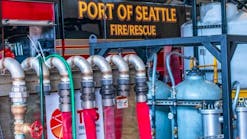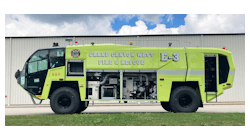New Aircraft Hangar Fire Suppression Standards: More Risks than Rewards?
Aircraft hangars pose unique challenges for fire protection since they differ in size and use. They are often large structures with high ceilings that house high-value business and commercial aircraft, their support equipment and associated maintenance activities. These uses have traditionally required a higher level of fire detection and suppression. However, modern hangars and aircraft are equipped with technologies providing more effective and sophisticated protection from potential ignition sources than ever before. While fire detection systems in hangars must adequately address unusual heights and distances, a rapid response must be balanced against the protection of life and property in the event of false alarms and consider advances in technology over the past two decades.
The National Fire Protection Association (NFPA), which sets standards for fire suppression and building codes, has proposed a new Standard on Aircraft Hangars (i.e., NFPA 409) requiring the installation of foam fire suppression systems in Group II hangars, which are those covering more than 12,000 square feet and with main doors up to 28 feet high. These changes are intended to help safeguard life and property through the proper construction and fire protection of hangars used for aircraft storage, maintenance or related activities. However, many in the aviation industry argue the risks outweigh the rewards in terms of negative economic impacts and the numerous hazards associated with inadvertent foam discharges.
Notably, the standards contained in NFPA 409 have no authority of their own, but become primary requirements when adopted by a local jurisdiction through its fire marshal or building and safety department. There are currently more than 300 codes and standards in place, with interpretations varying at the local level by authorities who exercise considerable discretion.
In terms of challenges to airport businesses, proposed changes to NFPA 409 contain two major mandates that place a tremendous financial burden on aircraft hangar owners without measurably increasing safety to structures or personnel. First, Group II hangars must incorporate foam fire suppression systems that require an enormous amount of water to operate and, second, foam and water must be collected in a cistern or other safe containment device. By some estimates, this equipment may cost approximately triple that of deluge type sprinkler systems (which typically allow a choice of water or foam) and, in some cases, may even equal the cost of the hangar itself.
In a survey conducted by the National Air Transportation Association (NATA) – the leading organization representing aviation service businesses such as fixed base operators, charter providers, aircraft management companies, and maintenance and repair organizations – over 77 percent of responding members stated the costs associated with implementation of these changes would prevent their construction of new hangars. Also, some companies are building smaller hangars to avoid the expense of installing a foam fire suppression system plus its associated maintenance and operational costs. For example, NATA estimates the incremental cost for a foam fire suppression system in a general aviation hangar ranges from $200,000 to $500,000 above a standard fire system. Placing this financial burden on aviation businesses, without evidence of increased safety, may have the negative consequence of limiting an airport’s healthy commercial development, future operations, economic health and community benefits.
Notably, since NFPA 409 was first established in the 1950s, the development of wide-body aircraft with extensive wing areas has caused the fear that a sprinkler discharge would be inadequate to contain a fuel spill before it reached another ignition source, such as other aircraft or equipment. Therefore, the historical trend by NFPA has been to reduce the role of sprinklers and advocate a system that can blanket the floor with foam discharged directly beneath the aircraft. However, a recent analysis of claims data conducted by Global Aerospace (www.global-aero.com), a worldwide provider of insurance to the aviation and aerospace industries, found no supporting evidence for replacing automatic sprinkler systems with foam fire suppression systems in Group II aircraft hangars due to this overarching concern.
In fact, the study indicates there has not been a single instance of a fuel spill fire causing activation of a hangar foam fire suppression system, and that false activations actually dominate insurance claim activity in this area. In fact, it is more likely for an inadvertent foam discharge to damage property, interrupt businesses and take aircraft out of service than a hangar fire. In the rare occurrence of a hangar fire, its origin is not typically aircraft fuel and it tends to occur in less sophisticated environments. This supports the conclusion that it is difficult, if not impossible, to reconcile fire loss history with the implementation of more stringent fire code requirements for Group II aircraft hangars.
It is even more critical to consider that when foam is inadvertently discharged, persons occupying the aircraft hangar have very little time to evacuate and can be instantly overcome by the volume of foam both ascending from the floor and descending from the ceiling. For example, Global Aerospace cites two events where there was no fire or loss of life, but the discharge of foam resulted in a terrifying experience for persons forced to escape the aircraft hangar. In addition, the inadvertent discharge of a foam fire suppression system resulted in a fatal event at a U.S. military base, during which a contractor was killed after being trapped in a hangar filled with foam. These raise serious questions about whether the codes and standards calling for more sophisticated fire suppression systems are disconnected from the risks in today’s aviation world. In fact, over the last 10 years, accidental foam discharges have resulted in more than $100 million in aircraft damage, with a clean-up cost of $20,000 to $40,000 per event. Global Aerospace adds that it can be extremely difficult to recover damages associated with foam discharge events, and recovery efforts can be long, arduous and unsuccessful.
Currently, the NATA is leading a collaborative effort among aviation industry professional associations, airport users and operators, fire protection experts and aviation insurance providers to influence the NFPA 409 technical committee to replace its seemingly-arbitrary foam fire suppression requirements for aircraft hangars with ones that are more risk-based. NATA is actively collecting data to more completely understand the costs arising from fire suppression systems and the risk of large fuel spill fires in Group II aircraft hangars. To participate in an industry survey and make your voice heard, visit www.nata.aero/foamsurvey
Curt Castagna, president and CEO of Aeroplex/Aerolease Group, is a member of the Los Angeles County Airport Commission, president of the Van Nuys and Long Beach Airport Associations, and board chair of the National Air Transportation Association. A certified private and instrument-rated pilot, he has instructed courses in aviation administration at Cal State Los Angeles for over two decades.




